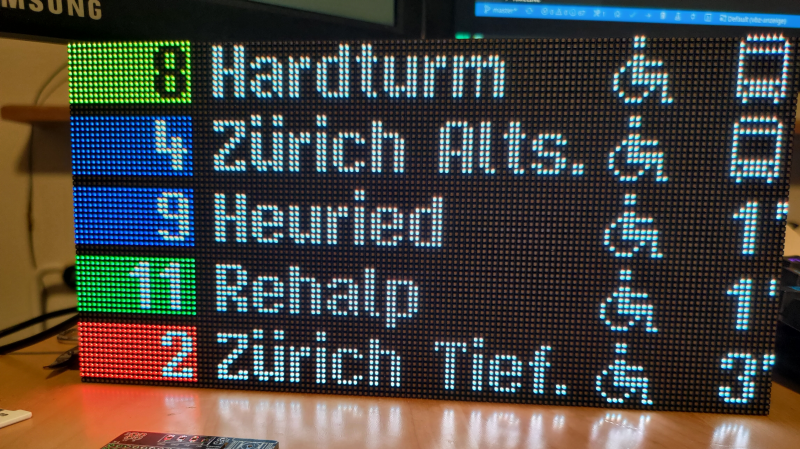[Stefan Schüller] was a fan of the LED signs that display arrival information for the trams and buses in their city of Zürich. [Stefan] was having trouble finding a source to purchase the signs so, instead, decided to build one himself.
[Stefan] decided to recreate the 56×208 single color 2mm dot pitch display with an 128 x 64 P2 RGB LED screen respecting the same 2 mm pitch. The display is driven by an ESP32 DMA RGB LED matrix shield utilizing a HUB75 RGB LED matrix library, all being powered from a 5 V 4 A power supply.
In addition to driving the LED matrix display, the ESP32 polls Zürich’s public transportation API and then parses the XML for the relevant information. Since [Stefan] wanted to match the fonts as closely as possible,
he created a new font from scratch, including the bus and accessibility icons. The new font was encoded into a glyph bitmap distribution format (BDF) that was then converted to work with Adafruit’s GFX library, with [Stefan] creating a custom conversion tool, called bdf2adafruit, to do the last leg of the conversion.
Since the LED matrix had full color capability, [Stefan] decided to add a little extra flourish and color code the transportation lines with the official tram colors. All source code is available on his GitHub repository for the project, for those looking for more detail.
We’ve featured DIY builds of public transportation feeds before. With the ubiquity of low cost RGB LED displays and public APIs, hopefully we’ll see many more!

















The Bürgermeister von Zürich might be interested in upgrading their signs. Locally made and supported; win-win all around. What do you think [Stefan Schüller]?
I think this would be a great idea and perhaps would be looked into by those in charge. However, over here in my end of the World (Western Canada), novel, cost effective, and superior ideas/products are not considered and/or ignored because there are too many large companies that supply such products (albeit not as versatile or cost effective) and so will do whatever they can to subvert a better product and especially one from an individual or smaller firm. That said, I wish the author all the best of success!
Companies do have to offer support, certifications, meet industry standards, design for mass manufacture, component sourcing, long term availability, warrranty, among other things. Of course Stefan could try to get his project into a product, but i’m not sure he could compete with already existing solutions.
Exactly, although my unit may be colored and more fancy looking it doesn’t compare to what the actual outdoor units need to endure. There is a reason the “real” ones costs thousandth of francs in comparison. This is just a desk/wall indoor toy.
You might be able to sell units to shopkeepers near bus stops, hereby making them offer customers a service and in the mean time keeping them in the shop for longer?
Spachen sind tückisch.
“There is a reason the “real” ones costs thousandth of francs in comparison” – that says the real displays cost 0.001 Franc. Thousands would be more like it.
Yes exactly. When spending public money low risk options with big support systems are always selected. Sure it’ll cost 5 times as much but it you’ll be able to keep spending that amount each year!
This is amazing, the font really gives me that “I’m going to make it home from Langstrasse before sun rise” feeling. Might have to build one. Awesome stuff!
best comment ever <3
“Hive or Hei” i would say
Did you find the RemoteSign and the Arrivals and Departure software that gets the data feeds and sends it to standard RemoteSign (ESP8266 or Windows)? See https://remotesign.mixmox.com/p/db.html
The API for RemoteSign is all documented so you can also feed in any data you want.